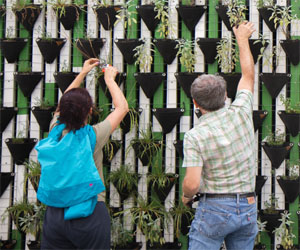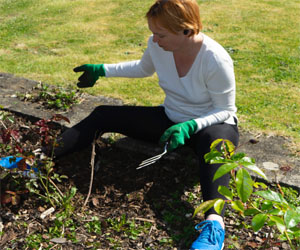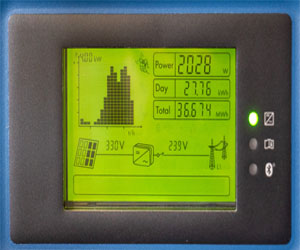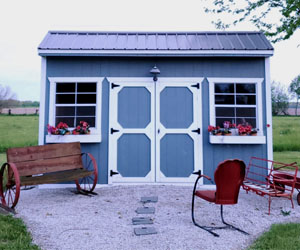


From Neglect To Paradise

Gardens have the remarkable ability to evolve and transform over time. Neglected or underutilized outdoor spaces can be turned into vibrant, welcoming paradises with a little creativity and effort. In this article, we'll explore the journey of garden transformation and the steps to take to turn your neglected garden into a place of beauty and serenity.
Assessment And Planning: The first step in any garden transformation is a thorough assessment of your space. Take a critical look at your garden, considering factors such as the current state of the plants, soil quality, layout, and potential issues like drainage problems. This assessment will help you identify the areas that need the most attention and guide your planning.
Clearing And Cleaning: For many neglected gardens, the first order of business is clearing away overgrown vegetation, weeds, and debris. This is the blank canvas upon which your transformation will unfold. Prune unruly branches, remove dead plants, and clear the ground to prepare it for new growth.
Soil Improvement: Healthy soil is the foundation of any successful garden. Assess your soil's condition and amend it as necessary. Adding organic matter like compost or well-rotted manure can improve soil structure and fertility, ensuring your plants have the nutrients they need to thrive.
Plant Selection: Choose plants that are well-suited to your local climate and growing conditions. Consider a mix of annuals, perennials, shrubs, and trees for a balanced and visually appealing garden. You can also incorporate native plants, which are adapted to the area and require less maintenance.
Garden Layout And Design: Carefully plan the layout of your garden. Consider elements like pathways, seating areas, and focal points. Create a design that not only enhances the beauty of your space but also ensures practicality and ease of maintenance.
Hardscape Elements: Incorporate hardscape elements like stone pathways, decorative walls, or patios to add structure and functionality to your garden. These features can create focal points and define different areas within the garden.
Proper Planting: When planting your chosen flora, be sure to give each plant the space it needs to grow. Pay attention to spacing, depth, and proper watering. Consider creating groupings of plants with complementary colors and textures to add visual interest.
Irrigation And Maintenance: Efficient irrigation is crucial to the health of your plants. Consider a drip irrigation system or soaker hoses to ensure consistent and controlled watering. Regular maintenance, including pruning, weeding, and mulching, will keep your garden looking its best.
Garden Accents And Decor: Garden transformation often includes the addition of decorative elements such as garden art, statues, or bird feeders. These accents can add personality and charm to your outdoor space.
Sustainability And Eco-Friendliness: As you work on your garden transformation, consider sustainable practices like composting, using natural pest control methods, and incorporating eco-friendly features such as rain barrels to collect and conserve water.
Patience And Enjoyment: Garden transformation takes time, so be patient and enjoy the process. Over the weeks and months, you'll witness your garden flourish and become a place of beauty and tranquility.
A neglected garden can be a hidden gem waiting to be uncovered. With careful planning, diligent effort, and a bit of creativity, you can transform your outdoor space into a paradise where you can relax, connect with nature, and enjoy the beauty of your garden for years to come.
The Heart Of Gardening Success
 2. Soil Care: Healthy soil is the foundation of strong, vibrant plants. Regularly assess the quality of your garden soil and amend it as needed. Composting, mulching, and using organic matter can improve soil fertility and structure. Understanding your soil's pH and nutrient levels will also help you select plants that are well-suited to your garden's conditions.
2. Soil Care: Healthy soil is the foundation of strong, vibrant plants. Regularly assess the quality of your garden soil and amend it as needed. Composting, mulching, and using organic matter can improve soil fertility and structure. Understanding your soil's pH and nutrient levels will also help you select plants that are well-suited to your garden's conditions.
3. Pruning And Deadheading: Pruning and deadheading are essential maintenance tasks that promote plant health and aesthetic appeal. Pruning involves trimming back overgrown or damaged branches, which encourages new growth and prevents disease. Deadheading is the removal of spent flowers to stimulate further blooms and keep the plant looking tidy.
4. Pest And Disease Management: Keep an eye out for common pests and diseases in your garden. Early detection and appropriate action are essential for preventing infestations. Consider using natural pest control methods to minimize the use of chemicals, which can harm beneficial insects and pollinators.
5. Fertilizing: Plants need nutrients to thrive, and fertilizing can provide a boost when your garden soil is lacking. Select a balanced, slow-release fertilizer and follow the recommended application rates. Over-fertilization can be harmful, so always adhere to the instructions on the product.


A Crucial Step Towards A Sustainable Future
 The Global Water Challenge
The Global Water Challenge
Water scarcity is a pressing concern that affects both developed and developing nations. Climate change, population growth, urbanization, and inefficient water management practices all contribute to this crisis. According to the United Nations, by 2030, nearly half of the global population will be living in areas with high water stress, underscoring the urgency of effective water conservation.
The Significance Of Water Conservation
Water conservation is the practice of using water more efficiently and minimizing waste. It is a fundamental approach to address the water crisis for several reasons:
Preserving Natural Ecosystems: Adequate water conservation ensures that freshwater ecosystems, such as rivers, lakes, and wetlands, maintain their vitality, safeguarding biodiversity and ecological balance.
Reducing Energy Consumption: Treating, transporting, and heating water demands substantial energy. Water conservation lowers energy use and carbon emissions, contributing to a greener environment.
Mitigating Water Pollution: By reducing water usage, less polluted water enters wastewater treatment plants, making the treatment process more effective and minimizing the release of contaminants into natural water bodies.
Paving The Way For A Smarter World
 Enhancing Everyday Life
Enhancing Everyday Life
Intelligent solutions are all around us, making our daily routines more convenient and enjoyable. Take, for example, the personal virtual assistants like Siri and Alexa, which have become integral parts of many households. These AI-driven solutions can answer questions, provide weather updates, control smart home devices, and even play your favorite music with a simple voice command. They are a prime example of how intelligent solutions have become an indispensable part of our lives, adding a layer of convenience and personalization to our everyday experiences.
Efficiency In Business
In the corporate world, intelligent solutions are optimizing business operations, boosting productivity, and improving decision-making processes. Data analytics, for instance, helps companies gain insights into customer behavior and market trends. This, in turn, allows for more informed and targeted marketing strategies, ultimately leading to better outcomes and growth. Additionally, the automation of repetitive tasks through intelligent solutions can free up employees to focus on more creative and strategic aspects of their work.
Healthcare And Well-Being
The healthcare industry is witnessing a revolution through the application of intelligent solutions. Telemedicine, for instance, allows patients to receive medical consultations from the comfort of their homes. Wearable health monitoring devices provide real-time data to both patients and healthcare professionals, helping to manage chronic conditions and improve overall health. Artificial intelligence is also aiding in the analysis of medical images, enabling more accurate diagnoses and treatment planning.
Transportation And Mobility
Intelligent solutions have the potential to redefine the way we move from one place to another. Autonomous vehicles are a prominent example. These vehicles use sensors, cameras, and AI algorithms to navigate roads and make split-second decisions, aiming to increase safety and efficiency in transportation. Additionally, smart transportation systems can help reduce traffic congestion and energy consumption, making our daily commutes more sustainable.
A Guide To Harnessing The Sun's Energy
 Sunlight Capture: Solar panels, typically mounted on rooftops, capture sunlight using photovoltaic cells. These cells are made of semiconductor materials, usually silicon.
Sunlight Capture: Solar panels, typically mounted on rooftops, capture sunlight using photovoltaic cells. These cells are made of semiconductor materials, usually silicon.
Electricity Generation: When sunlight hits the cells, it excites electrons in the semiconductor material, causing them to move and generate an electric current. This current is direct current (DC).
Inverter Conversion: Most of our electrical devices and appliances operate on alternating current (AC). To make the electricity compatible, an inverter is used to convert the DC into AC.
Energy Use Or Storage: The converted electricity can either be used immediately in your home or stored in batteries for later use, ensuring a constant supply of power even when the sun isn't shining.
Advantages Of Solar Power For Beginners
Environmental Benefits: Solar power is a clean and renewable energy source. It produces no greenhouse gas emissions, reducing your carbon footprint and contributing to a healthier planet.
Lower Energy Bills: By generating your electricity, you'll rely less on traditional utility providers, leading to significant savings on your energy bills.
Energy Independence: Solar panels provide a degree of energy independence. You're less vulnerable to power outages and price fluctuations from utility companies.
Property Value: Homes with solar panels are often more appealing to buyers, potentially increasing the value of your property.
Shaping A Sustainable Future
 Energy Efficiency: Energy-efficient design is a central aspect of eco-friendly design. This involves creating structures and products that require less energy to operate, thus reducing greenhouse gas emissions and energy costs.
Energy Efficiency: Energy-efficient design is a central aspect of eco-friendly design. This involves creating structures and products that require less energy to operate, thus reducing greenhouse gas emissions and energy costs.
Sustainable Materials: The use of eco-friendly materials, such as reclaimed wood, recycled metals, and low-VOC (volatile organic compounds) paints, is a cornerstone of eco-friendly design. These materials have lower environmental impacts and contribute to healthier indoor air quality.
Waste Reduction: Eco-friendly design encourages the reduction of waste at all stages, from manufacturing and construction to product use and disposal. This can include designing for disassembly and recycling.
Biomimicry: Biomimicry is a concept in eco-friendly design where designers draw inspiration from nature's solutions to complex problems. By imitating nature's strategies, designers can create more sustainable and efficient products and buildings.
Energy-Efficient Appliances and Systems: In architecture and interior design, eco-friendly design often incorporates energy-efficient appliances, lighting, and heating, ventilation, and air conditioning (HVAC) systems.
Water Efficiency: Eco-friendly design includes water-saving features such as low-flow faucets, dual-flush toilets, and rainwater harvesting systems. These measures reduce water consumption and promote water conservation.
Adaptive Reuse: In architecture and interior design, adaptive reuse is a strategy that involves repurposing existing buildings or structures rather than demolishing and building anew. This reduces waste and preserves historical and cultural significance.